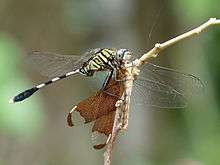Neurothemis fulvia
| Fulvous forest skimmer | |
|---|---|
 | |
| Male fulvous forest skimmer | |
| | |
| Female fulvous forest skimmer | |
| Scientific classification | |
| Kingdom: | Animalia |
| Phylum: | Arthropoda |
| Class: | Insecta |
| Order: | Odonata |
| Suborder: | Anisoptera |
| Family: | Libellulidae |
| Genus: | Neurothemis |
| Species: | N. fulvia |
| Binomial name | |
| Neurothemis fulvia (Drury, 1773) | |
Neurothemis fulvia, the fulvous forest skimmer, is a species of dragonfly found in India.[1]

Description
The fulvous forest skimmer (Neurothemis fulvia) is a medium-sized rusty dragonfly with transparent wing tips. Male is reddish brown whereas the female is paler brown in color.
Male has a reddish-brown face with eyes which are dark reddish brown above, golden brown below. Thorax, abdomen and legs are reddish brown. Wings are dark reddish brown with an irregular triangular transparent area at the tip of the wing. The wing spots are dark reddish brown.
Many forms of females are found. Color of head, thorax and abdomen paler than males or rusty brown. Wings are clear amber yellow with a dark ray extending to the tip in fore wing. Many of them have an irregular triangular transparent area at the tip of the wing. The wings vary in size, shape, width and coloration. Skimmers are the most diverse group of odonates. They are large, medium or small dragonflies and non-iridescently colored. Eyes are always broadly confluent.
Size: Male: Abdomen: 21-26mm, Hind wing: 27-32mm Female: Abdomen: 20-24mm, Hind wing: 26-32mm. [1]
Distribution and Habitat
It is a dragonfly of wet forests. Usually perches on fallen logs and shrubs. A large number of them can be found together in canopy gaps and forest edges. However, during the wet season, they move out of forested areas to non-forested bits. This family has worldwide distribution and is represented by 1139 species. Within Indian limits, 95 species are known, of which 50 species are found in the peninsular India.[2]
Ecology and Behavior
It breeds in marshes associated with forest streams and rivers. They are found throughout the year. However, large number can be seen between May-September.[1]
References
| Wikimedia Commons has media related to Neurothemis fulvia. |
- 1 2 3 K.A.Subramanian (2005) Dragonflies and Damselflies of India-A field guide. PDF
- ↑ http://www.ias.ac.in/initiat/sci_ed/lifescape/odonates-dragonflies.pdf Pg.73